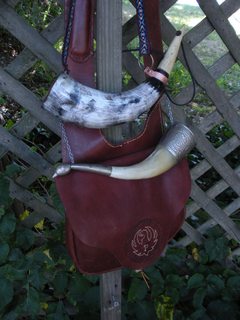This question is for the bag-makers in our group. I'm starting to work on my second bag, following the patterns in TC Albert's book. This time around I will be using the small strip of material that makes the bag a little fatter at the bottom.
My questions have to do with what I believe is referred to as a "welting" strip. I don't have the book in front of me, so forgive my lack of specifics here. But I'm talking about a small (3/8") strip of leather material that is sewn between the front flap and the back flap (or in this case the little strip of material that extends the bottom of the bag). This piece of leather material would then stick out a little between the two pieces of the bag (front/back) when the leather is turned inside out.
So.. Questions..
(1) Is this just for looks, or does it serve a function?
(2) I have a strip of pre-cut 3/8" leather from Tandy that I ordered for this purpose (I have a very difficult time cutting leather STRAIGHT). The piece that came in is about double the thickness of the leather I will use for the bag. Thoughts?
(3) I don't have a stitching pony or horse.. so I just hold my pieces together by hand and try to keep things straight. Any tips on how to make this process work better? It's not critical if I don't use this "welting" strip, but I think it is critical if I use it.
(4) Bottom line--is it worth it?
My questions have to do with what I believe is referred to as a "welting" strip. I don't have the book in front of me, so forgive my lack of specifics here. But I'm talking about a small (3/8") strip of leather material that is sewn between the front flap and the back flap (or in this case the little strip of material that extends the bottom of the bag). This piece of leather material would then stick out a little between the two pieces of the bag (front/back) when the leather is turned inside out.
So.. Questions..
(1) Is this just for looks, or does it serve a function?
(2) I have a strip of pre-cut 3/8" leather from Tandy that I ordered for this purpose (I have a very difficult time cutting leather STRAIGHT). The piece that came in is about double the thickness of the leather I will use for the bag. Thoughts?
(3) I don't have a stitching pony or horse.. so I just hold my pieces together by hand and try to keep things straight. Any tips on how to make this process work better? It's not critical if I don't use this "welting" strip, but I think it is critical if I use it.
(4) Bottom line--is it worth it?









